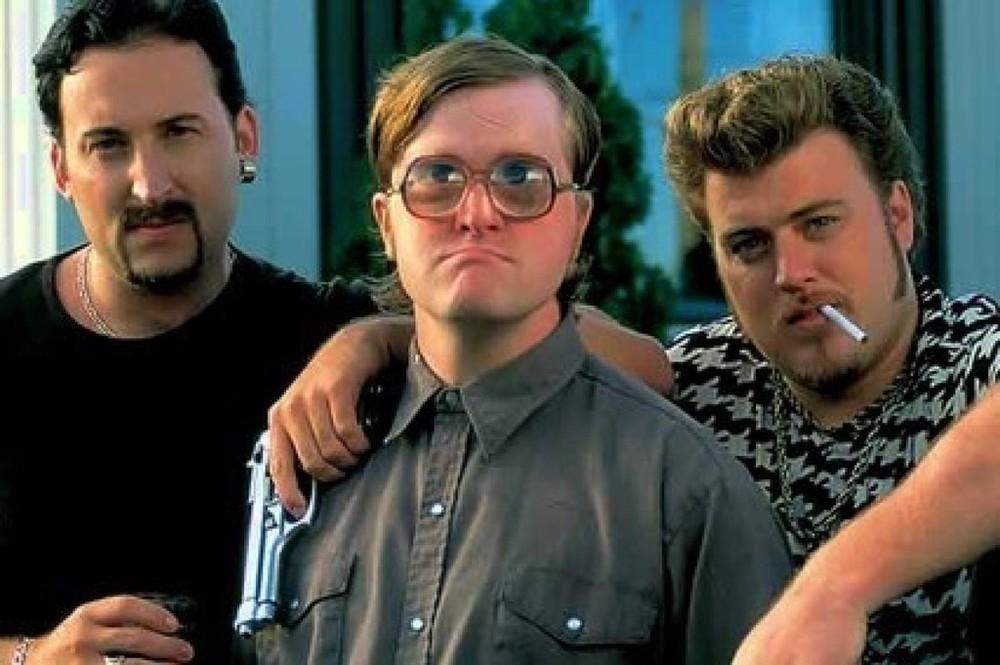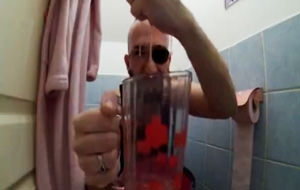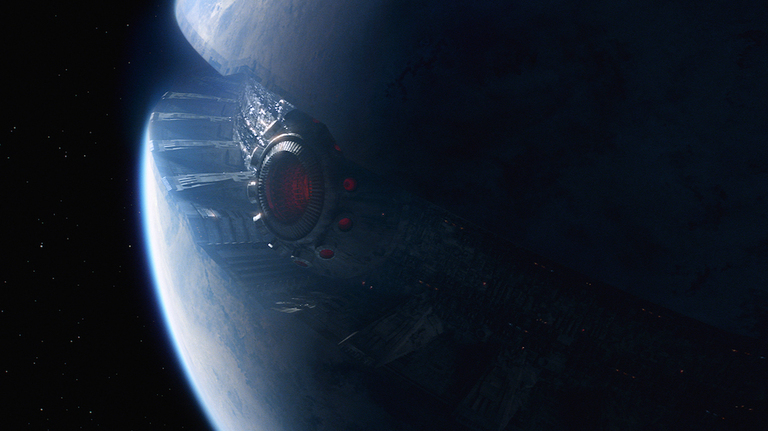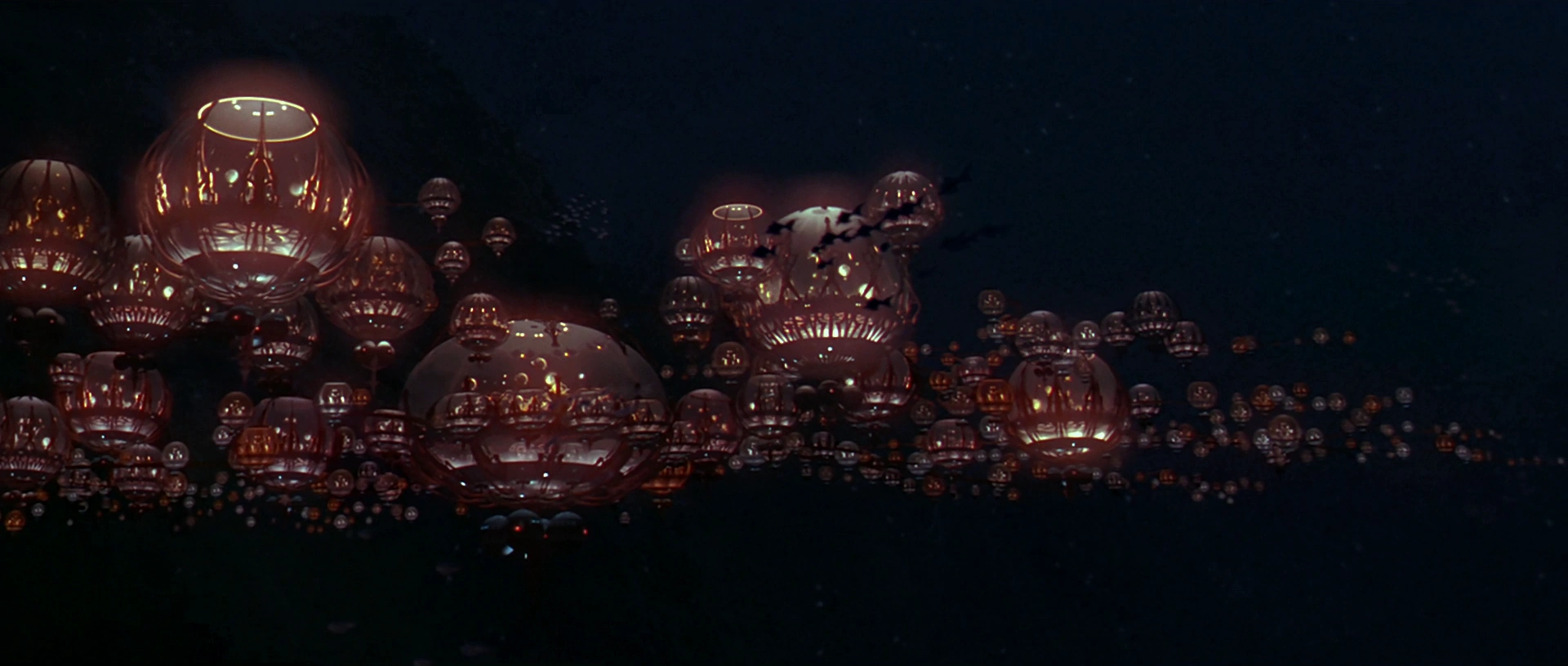
Image via 'Trailer Park Boys'
In June 2011, as it became clear that the Vancouver Canucks were going to lose game seven of the Stanley Cup finals to the Boston Bruins, thousands of drunken Canadian hockey fans watching the game on projector screens outside Vancouver's sports arena began to riot. For four hours they would burn police cars, tip over porta-potties, trap several hundred fans of the musical Wicked in the Queen Elizabeth Theatre, cause millions of dollars' worth of damage to downtown Vancouver, pose for some incredible photos, and, perhaps, plant a seed of interest in the mind of Americans like myself, who knew basically nothing about our neighbors to the north beyond the fact that they were supposedly pretty friendly, pretty quiet, and pretty weird.

Photo via Wikimedia
Of these photos, my favorite shows a skinny young guy in an impeccably matched hockey outfit standing alone in front of an overturned truck going up in flames. The flames are reflected in the back of his helmet, and this in combination with the unusually empty space makes him seem like the British Columbian incarnation of a very minor Greek chaos god, just zapped in for mischief. This effect is amplified by the perfect pyramidicity of his figure, which starts wide at the bottom with his cartoonish shorts, narrows as it goes up through his torso, and peaks in the towel, possibly aflame, that he's waving skyward in his right hand. His left arm is meanwhile thrust out at an exact ninety-degree angle from his right, forming what I imagine to be an exemplary semaphore-stance. He is, no doubt, calling in mythical reinforcements, his superiors in Canada's forces of chaos. And I have a pretty good idea who they might be.
Trailer Park Boys is now 15 years old and in its tenth season (recently premiered on Netflix), and, if the world were just, the joint anniversary would be marked Vancouver-style by public bonfires in city squares across North America. Instead, Ricky, Julian, and Bubbles will have to settle for the more private honor offered to them in the small gatherings held in the many personal shrines of the international cogno-scent-i. They will have to settle because, although a cult favorite and big in Canada, their show has never gotten its proper due or an international audience. This even though Trailer Park Boys has a pretty good claim to being the funniest and (or at least) the most unusual TV comedy of the past 15 years. Even though in its own quiet way it both anticipated and surpassed the metafictional conceits of recent critical darlings like Community. Even though it brings to the small screen, with an uncommon variety of dignity, a social class that usually exists there only to be mocked.
For those who don't partake: Trailer Park Boys is a Canadian mockumentary about three friends who scrape by on their own—not much family around—in Nova Scotia's Sunnyvale Trailer Park. Julian, the musclebound leader of the group, lives in a trailer; Bubbles, the awkward brains, in a shed next door; and Ricky, with all his stoned and pompadoured belligerence, mostly in his car out front. The title is maybe a bit ironic: they're not quite boys anymore, they look just a bit tired. Their lives revolve around the pursuit of other people's money—relatively small amounts, because money goes far when you live in your car and eat mostly gas-station pepperoni—and around the provocation of their two nemeses: Mr. Lahey, the alcoholic supervisor of Sunnyvale, and his assistant Randy, a cheeseburger fiend who refuses to wear a shirt. (Randy: "I don't wear shirts." The boys' friend J-Roc: "You better back off, you no-shirt, lawn-mowing, 15-cheeseburger-eatin' prick.")
Lahey loathes the boys for the reasons we love them: their tendency to shoot off guns in the park; their "willful destruction of garbage"; their endless schemes; the illegal massage parlors, bars, brothels, barber shops, and gas stations they open; their public drinking; their public smoking; their public urination (there's a refreshing attitude to public space in Trailer Park Boys); the trailers they burn down; the noise they make; and, above all, their immense energy, which resists any restraint. Lahey is the Inspector Dreyfus to their Clouseau, growing more frustrated and more insane as the years pass and time and again they slip through his fingers. All he wants is some peace and quiet, a "safe nice place we all want to be part of"; all they want is to "get a real job and grow some dope." (In case that isn't clear: the real job is growing some dope.)
Alas, the world won't let them—every season ends with the boys getting thrown in jail, their schemes having failed, and the next one begins with them getting out and trying again. Nothing much changes from season to season. It's not a bad thing: repetition, here, is the spice of life. No one affected by their schemes ever really gets hurt, and the boys always bounce back with relentless good cheer and optimism. As Ricky puts it, "jail is not that bad."
Trailer Park Boys is the child of Mike Clattenburg, a Nova Scotian screenwriter and producer who first thought up the three main characters in the mid-1990s and who helmed the show's original run from 2001-2008. (It's since been turned over to the actors behind the boys.) Clattenburg's vision is as tremendous as it is uncredited. The mockumentary style—single-camera format, interviews reflecting on the action, flashbacks, the elaborate season-longs arcs—he came up with is now common, but when Trailer Park Boys first went on the air in April 2001 there was little like it. The original UK version of The Office wouldn't premiere until two months later, never mind the American version, and Arrested Development, 30 Rock, and Community were still two, five, and eight years away. All those shows and more have come with great fanfare and gone to great lamentation in the last 15 years, while Trailer Park Boys, left out of the history blogs, has remained, quietly watching the style it helped pioneer revolutionize TV comedy. To be fair, much of the Canadian media loves Trailer Park Boys. But the American media has totally ignored it, even though enough Americans love the show that three years ago Netflix was persuaded to bring it back from the dead in the same way the company did for Arrested Development.
Why the lack of attention? The world of Trailer Park Boys is a world we've never really seen on TV, a backwater world of run-down fable or real-life cartoon (the show's closest relative is the turn-of-the-century Cartoon Network classic Ed, Edd n Eddy; the boys are basically grown-up versions of the Eds). It's a world that's so self-contained—and therefore foreign to those outside of it—it can be hard to get into. The boys rarely leave the park, don't have cell phones, only occasionally watch TV, and, for the earlier seasons, don't have internet. (Reading doesn't begin to enter into it.) A few cultural relics filter down, like the band Rush (which appears on the show), the nationally treasured restaurant chain Tim Hortons, and J-Roc's second-hand hip-hop, but that's about it. So there's little for outsiders to recognize and attach to—which has the thankful effect of protecting the show from the comforting web of pop-culture that smothers too many other comedies.
Once you're in, though, the isolation and the fellow-feeling it fosters turns out to be seductive. Hanging out with your friends all day, working out minor schemes, and lacking all ambition—it sounds particularly good to those of us from the American coasts. Most seductive of all is how unmediated the characters are. Their notions of how to behave and what to do aren't mirrored from the thrilling/overwhelming world of pop that each of us in the real world has to navigate every day. They're forced to entertain themselves, and as a result they're freer and more imaginative than we are. There's tattooed Sarah, whose schemes and enterprises make the boys' own look silly, and sweet Cory, a toothpick always—every scene he's in—dangling from his mouth, and J-Roc, who's "not crazy, he just genuinely believes he's black."
Freest and most imaginative of all is Ricky, Trailer Park Boys' (and modern TV comedy's) greatest accomplishment. Goatish terror, grower of cannabis, shepherd of morons, idiot savant of chaos, Ricky is Vancouver's hockey rioter returned to fable: the Pan of the redneck arcadia.
When Ricky writes, he numbers all of his sentences, because he learned to read on the back of microwave dinners. When he wants something to disappear—stolen bikes, grills, maxed-out credit cards—he throws it in the lake, because, "I've noticed that if you throw something into a water body, like a lake or an ocean, that the next day you come back and it's gone."
 Image via 'Trailer Park Boys'
Image via 'Trailer Park Boys'
Like any good mythic figure, Ricky is indestructible. Over the show's run he's been shot too many times to count, blown up in a bathtub, and frozen in his sleep by an out-of-control industrial air conditioner. Danny McBride's belligerent Kenny Powers from HBO's Eastbound and Down, another indestructible modern picaresque hero—and one who's seen considerably more fame and appreciation—owes Ricky his entire act.
And to whom do we owe Ricky? The Toast's Mallory Ortberg and Nicole Cliffe compare him to Falstaff—"A knave without malice, a liar without deceit, and a knight, a gentleman, and a soldier without either dignity, decency, or honor"—and they are as right about this as it is possible to be. Ricky is as entertaining as Falstaff and touches as deeply. Like Falstaff, Ricky loves pleasure—though he prefers hash and chicken fingers to sack and capons—but his true loves are his freedom and his friends. That his idea of freedom includes a trip to jail every year is no strike of hypocrisy against him, because he's free wherever his friends are, and they're usually in jail with him. Ricky's most lost when, as in the third season, they go to jail without him and he's forced to think for himself.
Thinking for himself turns out to be a problem. "Ricky's brain," Bubbles says, "doesn't work like other people's. Ricky can handle one thought at a time. You throw two or three at him, he's gonna fuckin' train-wreck." Or, in Ricky's own words, in a monologue delivered from jail:
"The thing with me is, I am smart and I'm smelf—I'm self-smarted basically by myself. Basically from nature and smoking drugs and doing different things, I've self, like, self learned myself... My brain doesn't use enough oxygen because I don't have the whole thing filled with different stuff and if it was full, it's only part full, and that's why I'm alive right now. Guards are givin' here, "Oh come, read this book, try to get smarter," and I'm like pfft, alright, well, I'll pretend to read it but I'm not gonna really read it 'cause then my brain would be more full, and if I have another heart attack I'm gonna die."
Watching his mind fall into chasms of thought like this, spinning out of control and then plunging gleefully toward ground, grasping for sense and then, when he can't find it, making it up, is the truest pleasure of the show. Ricky's attitude to language, like Falstaff's, is completely original. When he gets frustrated by a stuck door or window, he rips it out and hurls it away, and he does the same with words. His copious malapropisms and eggcorns range from the plain to the baroque to the nonsensical: from "water under the fridge" to "atodaso" ("I told you so") to "good things come to those at the gate."
The trailer park faithful have dubbed these "Rickyisms," and they share them widely on the internet with the same tone of admiration that grandfathers do with the sayings of Yogi Berra. What I think the admiration points to is the possibility that malapropism can be recognized as a form of cleverness rather than stupidity, as a better form of aphorism. After all, it's really quite an achievement to say one thing with words that mean something completely else. To do it again and again, that's one of Trailer Park Boys' signature tricks.

Photo via trailerparkboys.com
All the main characters are back in the new seasons, and the boys are still close as ever. Too close, perhaps. Until now the show's portrait of tight-knit male friendship had been the best I'd seen, far truer and more intimate than the self-consciously awkward Apatow "bromances" of the same mid-2000s period, with their "no homos" trailing unspoken behind their "I love yous." There's a quick moment in season four where Bubbles pops a spoonful of cereal into Julian's mouth in the middle of a conversation. No comment is made, no one thinks it's strange or praiseworthy, it's just there, given.
But in the new Netflix seasons (8, 9, and 10) the Apatow malady has struck. The boys now go around proclaiming feelings and pausing to emphasize their attitudes to race and sexual orientation. (There are several characters of color, all treated decently, and, when in an early season Lahey and Randy turn out to be lovers, no one bats an eye; not bad for the early 2000s.) These and more are all things we'd want to continue congratulating the show for, if we weren't now being hectored into it.
This isn't the only difference. The boys have started doing things as as normal as making videos for YouTube, as normal as going out to a restaurant—a sit-down, knife-and-fork restaurant!—to talk over dinner and wine. Their activities are still funny, but the perfect isolation, the vision into another world, has been spoiled. It seems the trailer park boys are catching up to the world.
And the world is likewise catching up to them. Not catching on—Trailer Park Boys gets as little attention as ever—but catching up, like TV comedy did to the show's formal innovation. This time it's in an awareness of the social reality the show's been portraying for 15 years, a reality which is now, thanks to a certain wild-haired, linguistically inventive Falstaff gone bad, at the center of American politics: the hollowing-out of the white working class. Avatars of the new white trash, the boys have basically no work, no family, no schooling, no religion, no unions—nothing to tie them down or to the wider world. The magic of Trailer Park Boys is that somehow in their hands Sunnyvale becomes a kind of communitarian dreamland rather than an atomized nightmare—an alternative vision of America if the left-behind could manage to band together rather than spin and be torn apart. Or, as J-Roc puts it, "In this park, it's one mafucka for all and all mafuckas for all mafuckas."
Follow Dan Kagan-Kans on Twitter.







 Leo getting ready to blow some cocaine into someone's ass in 'The Wolf of Wall Street'
Leo getting ready to blow some cocaine into someone's ass in 'The Wolf of Wall Street'


 Image via 'Trailer Park Boys'
Image via 'Trailer Park Boys'































 Wandering the fruit and vegetable markets in southern France can be inspiring. This year, we have spent some time in the big Sunday market in Libourne, about 40k outside Bordeaux on the Bergerac road. There was the usual range of wonderful stallholders, selling delicious produce at fantastic prices. I was attracted by some magnificent looking cherries. I wanted to buy them. The Wife advised, as she often does, caution. What were they for? Had I a plan? Did I know what I wanted to cook with them?
Wandering the fruit and vegetable markets in southern France can be inspiring. This year, we have spent some time in the big Sunday market in Libourne, about 40k outside Bordeaux on the Bergerac road. There was the usual range of wonderful stallholders, selling delicious produce at fantastic prices. I was attracted by some magnificent looking cherries. I wanted to buy them. The Wife advised, as she often does, caution. What were they for? Had I a plan? Did I know what I wanted to cook with them?


